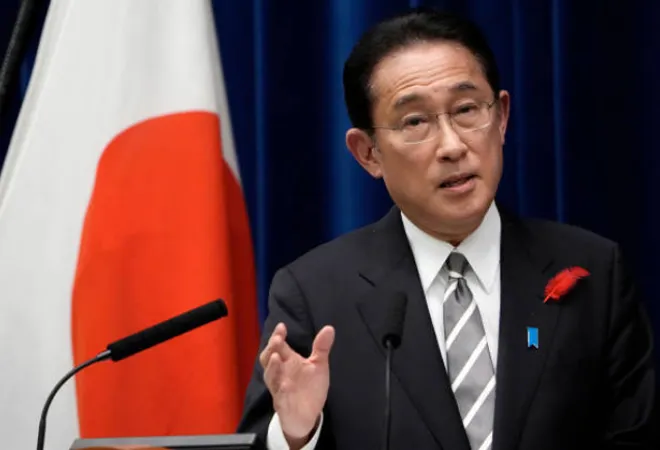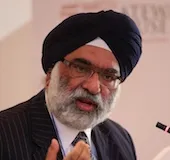
The new Japanese government of Prime Minister Kishida Fumio has two important defence-related issues at hand. The first is that it will craft a new National Security Strategy (NSS) by late 2022. This will replace the 2013 strategy which was adopted by the Abe government.
At the last elections, LDP supported an increase in the Japanese defence budget to up to 2 percent of GDP. This could rapidly raise the level to US $100 billion. Currently, it is at about 1.3 of GDP which amounts to US $48 billion.
These are significant policies for Japan to transition from an economic powerhouse to a country with full strategic responsibilities in its region. Moreover, the demand for amending the Constitution’s Article 9, which limits the use of the self-defence forces (SDF), could reach fruition under Kishida since he enjoys the support of his coalition partner Komeito and the Nippon Ishin no Kai. The conservative Kishida works to achieve the faster, incremental defence approach of Abe. The 1947 Constitution has never been amended; that requires approval by a two-thirds majority in both Diet chambers and passed in a referendum.
What has changed Japan's approach to its defence and NSS?
In the 1980s and 1990s, there were raucous protests against the erstwhile USSR, due to the occupation of the northern territories; however, this provocation was inadequate to push Japan over the 1 percent of GDP limit for defence spending, or to revise Article 9 of the Constitution. In the 21st century, the problems with Russia over the northern territories are unresolved. However, the threat to Japan is not perceived to be so much from Russia as from China and North Korea. The Defence White Papers in recent years have clearly identified the enemies from whom Japan could suffer.
A salient difference between Russia and China is that though Russia is in occupation of Japanese territory, as viewed by Tokyo, it is not considered a threat. Japan does not have much economic interface with Russia. With China, however, Japan is economically intermeshed to a high degree. Japan-China trade is US $280 billion, whereas Japan-Russia trade is only US $18 billion.
A salient difference between Russia and China is that though Russia is in occupation of Japanese territory, as viewed by Tokyo, it is not considered a threat.
It is China's reaction to the Senkaku islands, that has raised the hackles in Tokyo. The Chinese threat has goaded Japan into moving ahead on its defence and national security posture much more than its issues with the Russia ever did. In February 2021, the Coast Guard law of China (CCG) was amended to allow greater traction. Even prior to the new laws, CCG intruded for 333 days in 2020 with 1161 vessels in the East Asian Sea. The ambiguity of the new laws in operational use of arms heightens the threat to Japan.
What precisely is Japan trying to do?
First, by putting forth a new NSS, it will provide a framework for its ministries of defence and foreign affairs to work in. The extant NSS puts diplomacy at the top of the agenda on five of the six strategic approaches for the security of Japan. The new framework will allow for a response to emerging threats through enhanced defence partnerships. Second, it will increase its defence budget at a faster pace. This will give the SDF better response capacity
The third aspect would be an amendment of Article 9 of the Constitution. This is dependent on the results of the Upper House election in July 2022. If the LDP win that election, they would have adequate majority in both houses of the Diet to achieve this. The enunciation of a new NSS or doubling the defence budget are not tethered to an amendment of Article 9 and can go on nevertheless.
Japan will strengthen its engagement with the United States. The Defence White Papers show that Japan has reduced the development of its own weapon systems wherever the US is ready to provide them. Japan has increased its purchase of US weapon systems assuaging apprehensions of reduced exports to Japan in the normal way. F-35, US-2, C-2, PAC-3MSEs, and Type-16 mobile combat vehicles were planned purchases for 2021.
The Defence White Papers show that Japan has reduced the development of its own weapon systems wherever the US is ready to provide them.
With an additional US $50 billion a year, Japan can obtain more US weaponry, including stealth fighters, Osprey tilt-rotor utility aircraft, and surveillance drones. Indigenous production of amphibious landing craft, compact warships, helicopter carriers, submarines, satellites, and communications to fight a long war are envisaged. Japan is investing in the Electromagnetic Spectrum Domain as well. Research on potentially game-changing technologies including vehicles are underway.
There is a desire to improve understanding and expand the US–Japan partnership with greater responsibilities devolving upon Japan. From 2022, Japan will increase its share of costs to maintain US bases in Japan. From US $1.79 billion for 2021 it may rise to US $2 billion annually for the next five years. Thus, the Senkakus, the US Treaty, and the emergence of the Taiwan factor are now incentives for Japan to expand its defence expenditure and NSS. Japan and the US would not like to concede the space around Taiwan like China has taken over the spaces in the South China Sea with little resistance from the concerned ASEAN countries. Japan realises that its energy security and the presence of a large number of Japanese nationals and companies in Taiwan could jeopardise its security outlook.
Japan believes that a forward outlook on Taiwan will be a better defence for the Senkakus which are geographically the same chain. At present, Japan is doing little to effectively keep Chinese intrusions out of the East China Sea and these have been rising over the last two years. This requires will and capability.
Japan realises that its energy security and the presence of a large number of Japanese nationals and companies in Taiwan could jeopardise its security outlook.
Japan intends to play a bigger regional role since the Abe governmental policy. The Indo-Pacific strategy and the Free and Open Indo-Pacific (FOIP) provide Japan with greater responsibilities and partnerships in the region. The partnership with the US has attained greater momentum with the Biden administration and the 2+2 meetings between defence and foreign ministers now exist between all the Quad partners. Japan-US 2+2 took place in March 2021 and is now scheduled for January 2022.
Japan is increasing its supply of defence equipment to nearby ASEAN countries like the Philippines and Vietnam. These are part of their island defence strategy. The Maritime Self-Defence Force (MSDF) is playing a bigger role in exercises with Quad and partners in the Indo-Pacific.
The revised NSS will aim to challenge China’s assertiveness. Acquisition of greater defence capabilities are on the anvil. Will they be enhanced enough for first strike capabilities on North Korean and Chinese bases? Japan justifies these since North Korea and China both have missile capability of attacking Japan. The new hypersonic missile tests by China and North Korea accentuate the threat perception.
How will Japan react to an emergency in Taiwan?
Japan government institutions have simulated responses to Chinese-led upheavals in Taiwan. This includes protection of Japanese citizens, intelligence, logistics and base-sharing with the United States. It is doubtful whether Japan will contribute troops and ships to a defence of Taiwan in an emergency. On 2 December, former PM Abe, in a keynote speech at the 2021 Taiwan-U.S.-Japan Trilateral Indo-Pacific Security Dialogue, said “An armed invasion of Taiwan would be a grave danger to Japan. A Taiwan emergency is a Japanese emergency, and therefore an emergency for the Japan-US alliance.” Taiwan welcomed this view.
Any challenge to Taiwan would cause a disruption of energy supplies to Japan. This would impact its capability for strike mobility on the seas. Chinese observers believe that for a new posture, Japan would amend its NSS and its Constitution otherwise these ideas are unlikely to be implemented. China believes Japan uses China and the Taiwan issue to increase its defence expenditure, and this is unjustified!
Chinese observers believe that for a new posture, Japan would amend its NSS and its Constitution otherwise these ideas are unlikely to be implemented.
China would use this Japanese posture to startle ASEAN countries, who abhor such rivalry in their vicinity. China recently held its 30th anniversary summit with ASEAN, and the US Secretary, Anthony Blinken, visited Indonesia and Malaysia too. Both reassured ASEAN of good intentions. The previous Japan PM Suga had started his term by visiting Vietnam as did his defence minister. Vietnamese PM Pham Minh Chinh reciprocated and was the first foreign Summit for Kishida in Tokyo. Not giving up on ASEAN is part of Quad strategy. Japan will use its NSS to remain engaged with ASEAN under FOIP.
Japan may further enhance its cooperation with Europe as well. Japan may become the example for the European Union to increase their defence expenditure, revise their security guidelines, and become more potent strategic players. The attitude of Russia is the common thread. Europe has anxieties with Russia. Japan is now sensing that Russian policy is hardening.
The China-Russia axis is spinning on a different trajectory now with joint air exercises around the Kuril islands. Russia fears that a stronger US–Japan partnership may place missiles on the Kuriles and threaten eastern Russia.
The NSS and higher defence expenditure will raise Japan’s profile in the Indo-Pacific rapidly. A closer partnership with India is part of this enhancement. Japan is ready to transition from a diplomacy-led actor to an actor with a larger role for military diplomacy and superior preparedness. The uncertain neighbourhood demands such a recalibration.
The views expressed above belong to the author(s). ORF research and analyses now available on Telegram! Click here to access our curated content — blogs, longforms and interviews.




 PREV
PREV


